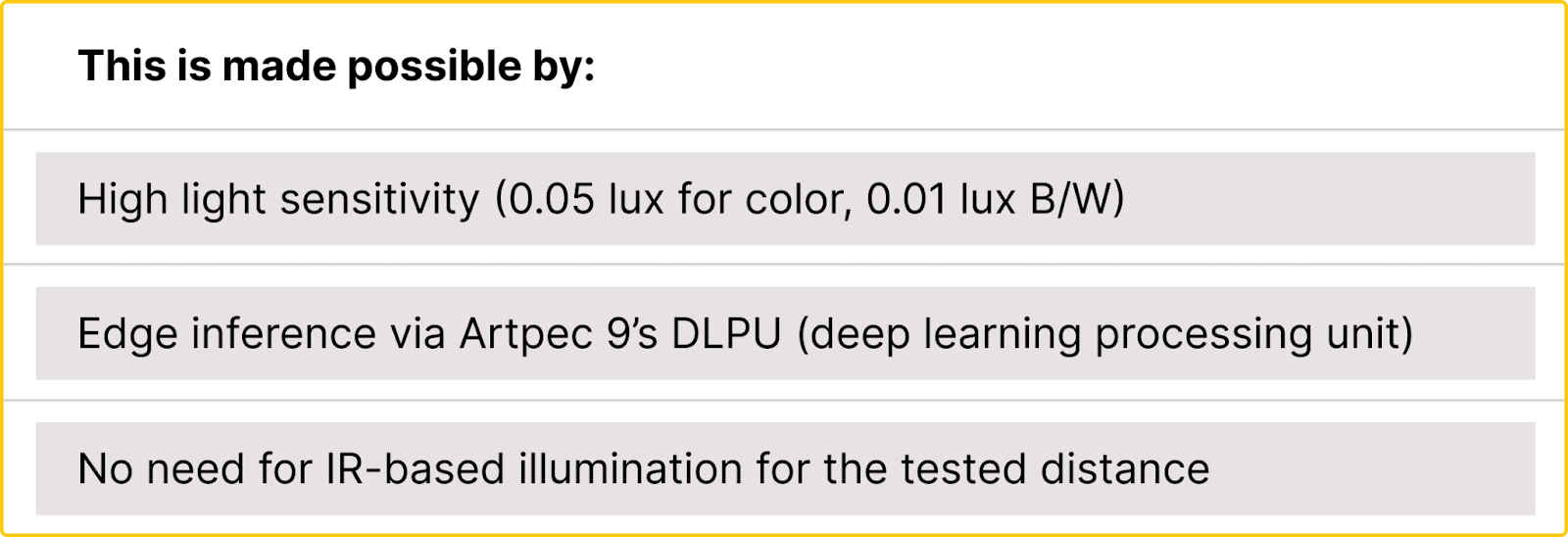
In traditional license plate recognition (LPR) systems, darkness has long meant compromise - either in performance or in data richness. Most cameras, including high-end models, switch to black-and-white mode at night to maintain plate recognition accuracy. That trade-off sacrifices critical attributes like vehicle color and often makes make-and-model recognition (MMR) unreliable after sunset.
But that’s changing.
In a recent real-world bridge test, the FF Group team ran CAMMRA AI on the Axis Q1728 block camera (Artpec 9), achieving promising results. CAMMRA AI not only delivered high capture and recognition rates at high speeds in low-light conditions, but did so while staying in full-color mode. It also accurately extracted make, model, and vehicle color, something previously considered impractical for edge-based LPR systems under night conditions.
This marks a significant milestone: the ability to identify a vehicle by its plate and appearance - in the dark, at speed, in real time - all on the edge.

To understand the breakthrough, we compared the Axis Q1728 (Artpec 9) with the company’s go-to standard, the Axis Q1800-LE (Artpec 8). Both were tested on the same high-speed bridge, under night conditions with limited artificial light and traffic traveling at 50-62 mph.
The Q1800-LE, tuned for LPR, performed exactly as expected: high capture rate, clear license plate reads - but only in black-and-white mode. That’s by design. As light drops, the camera switches modes and disables color to preserve contrast and clarity.
By contrast, the Q1728 stayed in full color, thanks to its large 1/1.2” RGB CMOS sensor - nearly three times larger in area than the sensor used in the Q1800-LE. Combined with Lightfinder 2.0 technology and Forensic WDR, this allowed the camera to retain color fidelity and deliver clean results even in difficult lighting. Not only did it detect and read license plates effectively, but CAMMRA AI running on the device also extracted vehicle make, model, and color - even under low-light, high-speed conditions.
CAMMRA AI was tested on the Q1728 camera without any software optimization applied. The results, achieved using standard model parameters, highlight both the adaptability of the AI pipeline and the significant performance boost provided by the latest Artpec 9 hardware.

The test setup mirrored FF Group’s standard benchmarking environment:
While the Q1800-LE operated in B/W mode, the Q1728, equipped with a larger 1/1.2" RGB CMOS sensor, advanced optics, and powered by the ARTPEC-9 SoC, captured high-resolution color frames throughout. CAMMRA AI’s real-time inference engine leveraged the improved light sensitivity and deep learning processing unit (DLPU) to analyze the video feed frame by frame, detecting vehicles, segmenting license plates, and classifying make, model, and color, entirely on the edge.
No additional lighting or server-side analytics were used.
With the Q1728, CAMMRA AI achieved:

In comparison, while the Q1800-LE (Artpec 8) remains an excellent LPR platform, its design prioritizes plate recognition only.
This result positions CAMMRA AI + Axis Q1728 as a future-ready solution for:
This early test of CAMMRA AI on the Artpec 9-based Axis Q1728 demonstrated both compatibility and strong performance. For the first time, full-color MMR and plate recognition were achieved at night, under real conditions, on a device not yet tuned for the job.
As AI-based traffic systems mature, the ability to process color, identity, and motion context together - at the edge - will become the standard. With Artpec 9 and CAMMRA AI, that standard is no longer theoretical.